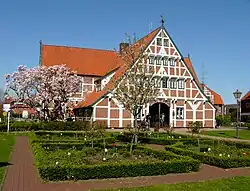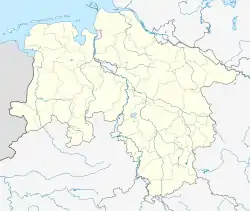Jork
Jork is a small town on the left bank of the Elbe, near Hamburg (Germany).
Jork | |
|---|---|
 Town hall | |
 Coat of arms | |
Location of Jork within Stade district  | |
 Jork  Jork | |
| Coordinates: 53°32′04″N 09°40′54″E | |
| Country | Germany |
| State | Lower Saxony |
| District | Stade |
| Subdivisions | 7 districts |
| Government | |
| • Mayor (2019–24) | Matthias Riel[1] |
| Area | |
| • Total | 62.27 km2 (24.04 sq mi) |
| Elevation | 4 m (13 ft) |
| Population (2021-12-31)[2] | |
| • Total | 12,085 |
| • Density | 190/km2 (500/sq mi) |
| Time zone | UTC+01:00 (CET) |
| • Summer (DST) | UTC+02:00 (CEST) |
| Postal codes | 21635 |
| Dialling codes | 04162 |
| Vehicle registration | STD |
| Website | www.jork.de |
.jpg.webp)
Jork belongs to the district of Stade, in Lower Saxony. The town is the capital of the Altes Land, one of the biggest fruit growing areas in Europe, and Jork is home to a Fruit Research Center.[3][4]
History
Jork was mentioned for the first time in a deed in 1221, then it belonged to the Prince-Archbishopric of Bremen in secular respect.[5] As to religion Jork belonged to the Roman Catholic Diocese of Verden (till 1648).[5] In 1648 the Prince-Archbishopric was transformed into the Duchy of Bremen, which was first ruled in personal union by the Swedish and from 1715 on by the British and Hanoverian Crown. In 1807 the ephemeric Kingdom of Westphalia annexed the Duchy, before France annexed it in 1810. In 1813 the Duchy was restored to the Electorate of Hanover, which - after its upgrade to the Kingdom of Hanover in 1814 - incorporated the Duchy in a real union and the ducal territory, including Jork, became part of the Stade Region, established in 1823. From 1885 to 1932 Jork served as the capital of the Prussian District of Jork, comprising Altes Land, the city of Buxtehude and its today component Neuland, then still an independent municipality. The former district forms since a part of today's District of Stade.
 Borstel windmill
Borstel windmill Museum Altes Land
Museum Altes Land Esteburg castle
Esteburg castle Launch "Nordsee VII" passing the swing bridge at Jork-Estebrügge
Launch "Nordsee VII" passing the swing bridge at Jork-Estebrügge
Division of the town
Jork consists of seven districts:
- Borstel
- Estebrügge
- Hove
- Jork
- Königreich
- Ladekop
- Moorende
References
- "Verzeichnis der direkt gewählten Bürgermeister/-innen und Landräte/Landrätinnen". Landesamt für Statistik Niedersachsen. April 2021.
- "LSN-Online Regionaldatenbank, Tabelle A100001G: Fortschreibung des Bevölkerungsstandes, Stand 31. Dezember 2021" (in German). Landesamt für Statistik Niedersachsen.
- R. Stehr: Screening of sweet cherry cultivars in northern Germany, International Society for Horticultural Science
- Seed and Plant Genetic Resources Service - AGPS,
- Michael Schütz, „Die Konsolidierung des Erzstiftes unter Johann Rode“, in: Geschichte des Landes zwischen Elbe und Weser: 3 vols., Hans-Eckhard Dannenberg and Heinz-Joachim Schulze (eds.) on behalf of the Landschaftsverband der ehemaligen Herzogtümer Bremen und Verden, Stade: Landschaftsverband der ehemaligen Herzogtümer Bremen und Verden, 1995 and 2008, vol. I 'Vor- und Frühgeschichte' (1995; ISBN 978-3-9801919-7-5), vol. II 'Mittelalter (einschl. Kunstgeschichte)' (1995; ISBN 978-3-9801919-8-2), vol. III 'Neuzeit' (2008; ISBN 978-3-9801919-9-9), (=Schriftenreihe des Landschaftsverbandes der ehemaligen Herzogtümer Bremen und Verden; vols. 7–9), vol. II: pp. 263–278, here pp. 270seq. ISBN 978-3-9801919-8-2.